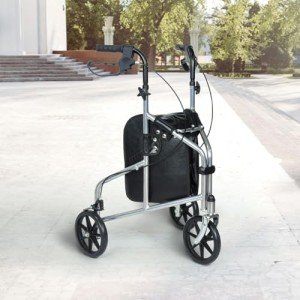
10
MaySee What Walking Aids Tricks The Celebs Are Using
Walking Aids: Enhancing Mobility and Independence
Walking aids are vital tools designed to help people Rollator With Seat mobility difficulties, allowing them to move easily and comfortably. These gadgets can significantly improve autonomy, improve posture, decrease the risk of falls, and increase general lifestyle. This article looks into different kinds of walking aids, their benefits, considerations for use, and suggestions for picking the best aid. Furthermore, a comprehensive FAQ area addresses common questions about walking aids.
Kinds Of Walking Aids
Walking aids been available in different forms to accommodate various requirements and choices. Below is a categorized list of the most frequently utilized walking aids:

1. Canes
- Standard Canes: A single straight walking cane for basic assistance.
- Quad Canes: Canes with a four-pronged base for increased stability.
2. Walkers
- Requirement Walkers: Frame-like gadgets that supply support on all sides, excellent Rollator For Travel those with minimal strength.
- Rolling Walkers (Rollators): Equipped with wheels, these enable users to walk with less effort and come with seats for resting.
3. Crutches
- Axillary Crutches: Used under the arms; ideal for temporary mobility concerns.
- Lower Arm Crutches (Lofstrand Crutches): Designed for long-term use, they need grip strength and are lighter than axillary crutches.
4. Wheelchairs
- Handbook Wheelchairs: Require user effort to move, offering flexibility and independence.
- Electric Wheelchairs: Battery-powered choices suitable for users Rollator With Storage limited arm strength.
Benefits of Walking Aids
Walking aids offer various advantages that contribute to enhanced mobility, safety, and self-reliance. Some key benefits consist of:
- Increased Stability: Walking aids supply extra points of contact with the ground, decreasing the threat of falls.
- Improved Mobility: They allow movement over higher ranges, allowing people to engage in social activities and daily tasks.
- Pain Reduction: Properly fitted walking aids can ease pressure on joints and decrease discomfort related to different medical conditions.
- Enhanced Confidence: Using a walking aid can enhance a person's self-confidence, encouraging them to explore their environment without worry.
- Posture Support: Aids assist preserve correct positioning and posture, decreasing stress on the back and hips.
Factors To Consider When Choosing Walking Aids
Selecting the right walking aid is crucial for safety and efficiency. Here are some factors to consider:
1. Individual Needs
- Examine the level of assistance required for mobility.
- Think about whether short-term or long-term assistance is required.
2. Environment
- Assess the terrain and surface areas (indoor vs. outdoor) where the aid will be used.
- Guarantee that the walking aid is ideal for stairs, ramps, or unequal surfaces.
3. Weight and Portability
- Examine the weight of the walking aid and if it can be carried quickly.
- Lightweight Nitro Rollator: Your Mobility Solution alternatives are more suitable for those who may need to raise or stow the aid regularly.
4. Comfort and Fit
- Make sure the walking aid is adjustable and fits the user's height.
- Consider grips, armrests, or seats that offer comfort for extended use.
5. Budget plan
- Determine a budget for the walking aid while considering the quality and functions required for the user's safety and comfort.
Frequently Asked Questions About Walking Aids
1. Who should use walking aids?
Walking aids appropriate for people recuperating from surgical treatment, those with persistent discomfort, seniors experiencing balance issues, or anyone with a mobility challenge.
2. How do I select the best height for a walking aid?
When standing directly with good posture, the top of the walking cane or Rollator Walker Safety must align with the wrist bone. A healthcare expert can offer assistance during fitting.
3. Can I use a walker on stairs?
While it's normally not safe to use a walker on stairs, some walkers are developed particularly for stairs with features that boost stability. Constantly talk to a physiotherapist for customized suggestions.
4. How can I keep my walking aid?
Routinely look for loose parts, wear and tear, and tidy the gadget according to the maker's instructions to ensure safety and longevity.
5. Do walking aids assist with balance?
Yes, walking aids can supply the needed assistance and stability, assisting to avoid falls and help with well balanced motion.
Walking aids are vital gadgets that empower individuals with mobility challenges to maintain independence and improve their quality of life. By comprehending the different kinds of walking aids, their benefits, and important factors to consider for choice, users can make informed choices tailored to their needs. Whether for short-lived support or long-lasting use, the right walking aid can transform day-to-day regimens and boost overall well-being.
| Type of Walking Aid | Functions | Best For |
|---|---|---|
| Walking sticks | Single or quad bases | Moderate support |
| Walkers | Repaired or rolling alternatives | Lower body weak point |
| Crutches | Axillary or forearm designs | Short-term mobility concerns |
| Wheelchairs | Manual and electric choices | Severe mobility restrictions |
Welcoming the best walking aid can cause newly found liberty and a more active way of life, cultivating self-reliance and social engagement. As always, consultations with health care experts can offer individualized suggestions to guarantee safety and efficiency in utilizing walking aids.


Reviews